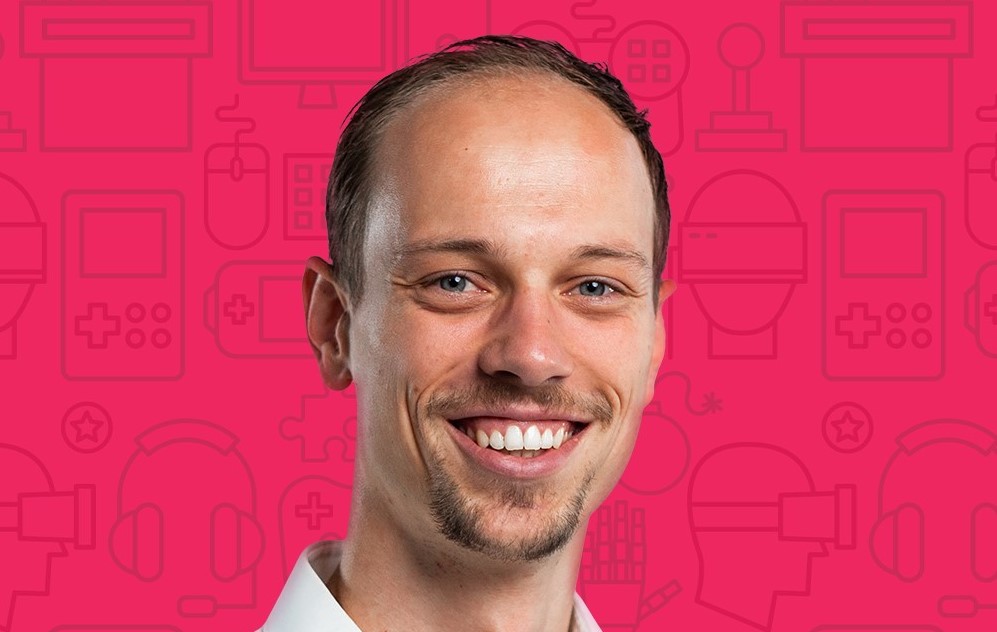"I immerse people in the world of digital learning technologies"
Interview with Sander Giesselink by Diana Dalenoord
I am an Immersive Learning Specialist at UP Learning. This is a company dedicated to creating the ultimate blend of learning, knowledge sharing and modern technology such as interactive video, virtual reality, augmented reality and e-Learning. I work as a content developer, where I create immersive learning content and host learning solutions. I am interested in using immersive/new technologies to improve learning for employees, making it easier and more engaging. They are immersed in a new digital world, so to speak.

My creations
Through virtual reality, I take people to a place that is not always reachable. These can be dangerous scenarios, such as during fire drills. Another good example is the digital training that we have developed for staff who supply aircraft kitchens. They need to set up the kitchens in a short period of time and must know exactly what is where. By practising this virtually, they will be able to do this quickly and efficiently.
With VR you can easily create multiple layouts and have these always available for training. For instance, an airline has multiple planes with different kitchen layouts and when you want to train the staff on the ground, the planes need to be in the air. In developing this VR, we used the Unity Tool that I learned about during the CreaTe programme. In this job, you have a lot of creative freedom and develop a lot yourself.
A more approachable application is augmented reality for which you use the program Zappar. Zappar is a tool specifically for creating "simpler" AR experiences and you can use an existing app. Unfortunately, it offers you, therefore, less creative freedom. An example of an AR project I've worked on is AR training for microscopes that use X-rays to make 3D scans. For safety reasons, these microscopes must be scanned for radiation leaks. This must be done very carefully. The speed of scanning is extremely important here, namely 1 cm per second. Through an application (with sensors) on a cell phone, the speed and importance of scanning are explained. After watching an animation in AR that explains the importance of scanning speed. You play a mini-game to practice scanning 1 cm per second. The application gives you immediate feedback, which is helpful because most people scan way too fast. Through this activity, they get a better sense of good scanning and can thus improve the quality of their scans.
A third development is 360 interactive video, which adds interactions and uses a special type of camera to create videos that look lifelike. It is a powerful tool despite the fact that the development takes less time and is, therefore, cheaper compared to VR and AR. The scenes are close to reality and interactive. You can make choices and see the effect immediately. These videos give you the opportunity to practice what to do in difficult, or even dangerous, situations. You can make wrong choices that with 360 VR are no risk, but which in the real world can put you in danger. For example, a 360 video trains you to deal with an aggressive customer in a supermarket. Because of the 360 VR, this customer can come very close to you or even enter your personal space. Such a situation can seem intimidating, but it is a very safe environment in which to practice how to handle threatening circumstances.
What did you learn in Creative Technology?
The Bachelor’s in Creative Technology has given me a good toolbox to carry out these kinds of projects using the Unity Tool, as well as programming and modelling in 3D. I also learned to work together in a multidisciplinary group. After all, you obviously don't have all the knowledge yourself and therefore you rely on others. At UP Learning, I not only work with engineers but also with educationalists who focus on the learning aspect. And graphics designers that make everything look amazing. I chose to study CreaTe because I wanted to make things. During the many projects, I was given the opportunity to invent, and then build those inventions. I enjoyed figuring out how a device worked and exploring what else was possible. My interests were very broad and this programme offered me challenges not only in design and hardware but also in pure software development.
A life after CreaTe
It was a natural choice to do the Master's in Human Media Interaction (ed. now this programme is called Interaction Technology). During my graduation project, I researched how to use and apply AR to improve learning CPR with an instructor who is virtually present. What I learned then, I still use in my current job as an Immersive Learning Specialist.
What are your future plans?
I haven't given much thought to future plans. Right now I am very satisfied with my current job with its many challenges of teaching people to learn digital learning concepts and techniques. It remains a challenge to always look for the right technology to match a client's learning request and then use that technology in a smart way to enhance the learning effect as much as possible. It doesn't always have to be AR/VR or interactive video. But if it is, the trick is to make the most of it and make the learning experience as accessible as possible.

Name: Sander Giesselink
Bachelor’s: Creative Technology at the University of Twente, Netherlands
Master’s: Human Media Interaction (now Interaction Technology) at the University of Twente, Netherlands
Work: Immersive learning specialist at UP Learning, Ede, Netherlands
UP Learning offers opportunities for internships. ℹ️ info@uplearning.nl
